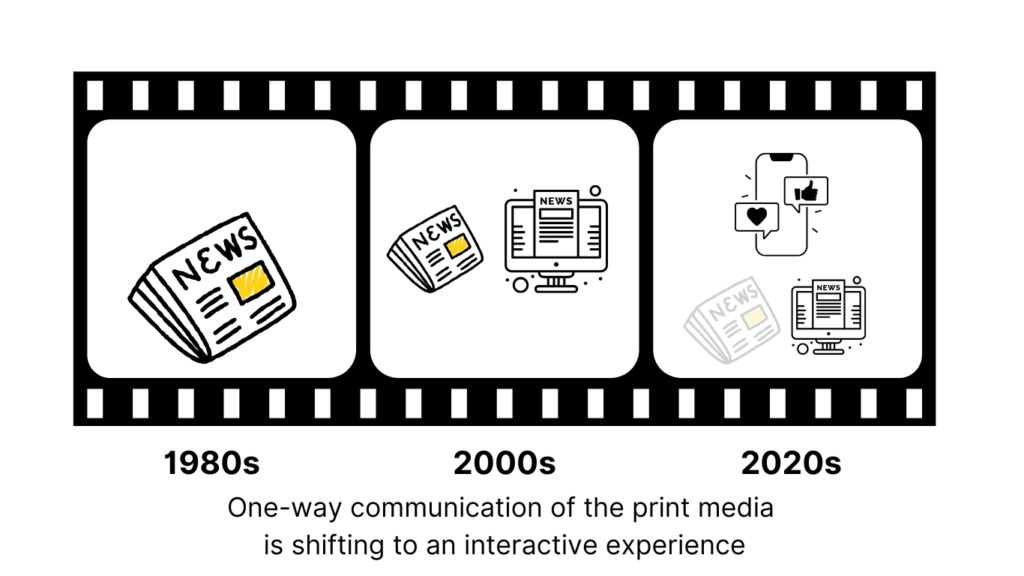In an age dominated by digital interactions, the way we consume news is undergoing a seismic shift. This change is particularly evident among young readers, who are redefining news consumption and subscription behaviours.
For publishers, news enthusiasts, digital product managers, and magazine owners, understanding this evolution is crucial to staying relevant and competitive in today’s fast-paced world.
Let’s explore how young readers are changing the game, and what it means for the future of news.
Table of Contents
ToggleNews is being consumed differently today
The rise of digital platforms has irrevocably transformed how young people access news. Unlike previous generations who relied on newspapers and television, today’s youth predominantly turn to social media, mobile apps, and digital platforms for their daily news fix.

According to the Pew Research Center, in the US, 4 out 10 adults under 30 get their news from TikTok, highlighting the platform’s growing influence among younger demographics.
Another Pew Research Center report shows a third of U.S. adults say they regularly get news on Facebook and YouTube. Additionally, about half of TikTok users report regularly getting news from the platform, showcasing its increasing role as a news source.
This shift is not just about convenience; it’s about engagement. Young readers are more likely to consume news that is visually appealing and easily shareable within their social networks. For publishers, this trend signifies a need to adapt content strategies to meet the demands of a digitally native audience.
The evolution of news subscriptions
To understand the current landscape, it’s helpful to take a historical look at how news subscriptions have evolved. Traditionally, news subscriptions were straightforward—consumers paid for a daily newspaper or a monthly magazine.
However, with the advent of the internet, subscription models have diversified. Today, we see a mix of paywalls, freemium models, and even micropayments for individual articles.
Currently, news organizations are experimenting with various subscription models to find the right fit for their audiences. This experimentation is crucial as publishers attempt to balance accessibility with revenue generation. The effectiveness of these models often hinges on delivering value that resonates with young readers, who may be less inclined to commit to long-term subscriptions.
Factors influencing subscription decisions
Several factors influence young readers’ decisions to subscribe to news services. Personalization is key. Young consumers prefer content tailored to their interests and lifestyles. The ability to customize news feeds and receive recommendations based on past behaviour can significantly enhance user engagement.
User experience also plays a vital role. Seamless navigation, intuitive design, and fast-loading pages contribute to a positive experience that can convert casual readers into loyal subscribers. Additionally, exclusive content and subscriber-only deals are powerful incentives that can tip the scales in favour of subscribing.
Case studies and success stories
Many publishers have successfully adapted to the changing subscription landscape by aligning their strategies with the preferences of young readers. For instance, The New York Times has seen significant growth in digital subscriptions by offering a blend of quality journalism and innovative digital features. Similarly, smaller outlets like Vox and BuzzFeed have carved out niches by delivering content that resonates with younger audiences, often incorporating multimedia storytelling and interactive elements.
These success stories highlight the importance of understanding audience needs and leveraging technology to meet those needs. By doing so, publishers can not only survive but thrive in a competitive market.
Future of news subscriptions
Looking ahead, the future of news subscriptions is promising but requires continuous adaptation. Emerging technologies such as artificial intelligence and machine learning hold the potential to further personalize news experiences. These technologies can help publishers predict reader preferences and deliver content that anticipates their interests.
Additionally, as more young readers seek sustainable and ethical media practices, transparency and trust will become increasingly important. Publishers who can demonstrate a commitment to these values are likely to retain and grow their subscriber base.
Recommendations for publishers and digital product managers
To capture and retain the interest of young readers, publishers and digital product managers should consider the following strategies:
- Invest in personalization: Use data analytics to understand reader preferences and tailor content accordingly.
- Enhance user experience: Focus on creating seamless, enjoyable digital experiences combining desktop and mobile experiences (browser and app) that keep readers engaged.
- Leverage social media: Use platforms that young people frequent to distribute content and interact with the audience.
- Offer flexible pricing models: Provide a range of subscription options, including micropayments, to appeal to different consumer preferences.
- Experiment to gain deeper understanding: Conduct controlled experiments to gain deeper insights and to lead user to deeper interactions with your publication.
By adopting these approaches, publishers can position themselves for success in a rapidly changing media landscape.
Conclusion
The shifting dynamics of news consumption among young readers present both challenges and opportunities for publishers. By understanding and adapting to these trends, publishers can enhance their relevance and strengthen their connection with this pivotal demographic.
It’s time for the industry to evolve alongside its audience, fostering a future where quality journalism and engaging content go hand in hand. Let’s continue to explore, innovate, and create a media environment that meets the needs of the next generation.
For those looking to deepen their knowledge or seek guidance, consider connecting with experts who can provide personalized insights and strategies. The future of news is here—it’s time to be part of the change.
Disclosure: AI tools were used to guide the research and ideas presented in this article.
